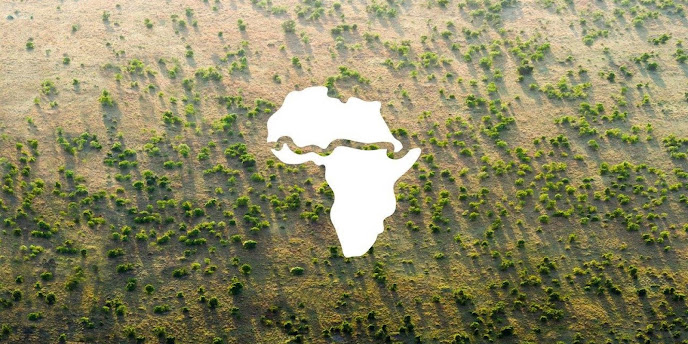Sahel's Rainfall Variability: Sea Surface Temperature Anomalies
Since the 1990s, with the refutation of vegetation-rainfall feedbacks as the primary driver of Sahel's rainfall variability and model developments, a consensus has been reached that the changes in Sea Surface Temperatures (SSTs) are the main reason behind Sahel's rainfall variability, especially on interannual and decadal timescales and supported by large amounts of modelling studies (such as Giannini, Saravanan & Chang, 2003; Cook, 2008; Rodríguez-Fonseca et al., 2011; Nicholson, 2013; Hill et al., 2017). Rodríguez-Fonseca et al.(2015) also provide a very nice and comprehensive review of the relationships between Sahel's precipitation and SST anomalies. The following sections will discuss the influence of different ocean basins (the tropical Atlantic Ocean, Mediterranean Sea, Pacific Ocean and the Indian Ocean) on Sahel's rainfall and at two timescales, interannual and decadal.
Interannual time scales
a. The tropical Atlantic Ocean
Studies have shown that at interannual time scales, the equatorial tropical Atlantic Ocean affect the precipitation over the Sahel and the dominant mode is the Atlantic Niño, which is marked by warming (cooling) over the equatorial Atlantic during the boreal spring-summer coupled with relaxation (strengthening) of the trade winds and deepening (swallowing) of the eastern equatorial thermocline (Rodríguez-Fonseca et al., 2015). Earlier research links the warming of the tropical Atlantic with precipitation reductions in the Sahel and increases over Guinea due to the weakening of land-ocean sea level pressure gradient and ITCZ shift (Ward, 1998). However, a more recent study shows an insignificant association between Atlantic Niño and Sahel's rainfall (Polo et al., 2008). Rodríguez-Fonseca et al.(2015) conclude that the errors in simulating the influence of the tropical Atlantic Ocean are significant.
b. The Mediterranean Ocean
Research suggests a positive link between the SST anomalies in the Mediterranean Sea and the precipitation over the Sahel. The low-level flow across the eastern Sahara advects the increased moisture content in the lower troposphere due to enhanced evaporation caused by warming in the Mediterranean Sea into the Sahel, strengthening the moisture convergence over the Sahel and its precipitation (Rowell, 2003; Fontaine et al., 2010; Rodríguez-Fonseca et al., 2015). Precisely, Gaetani et al. (2010) show that the positive SST anomalies in the eastern Mediterranean Sea lead to the northward shift of the monsoon, and this moisture transport is maximised in July-August over the Sahel when the monsoon circulation is completely inland.
c. The Pacific Ocean
The results from modelling experiments examing the relationship between the Pacific Ocean SSTs and Sahel's rainfall in 1979-2002 show that warming over the Pacific Ocean has a negative impact on Sahel's precipitation at interannual scales generally. More specially, their relationships vary between different seasons. From May to June, due to the equatorial heating in the Pacific, abnormal subsidence advanced over the Maritime Continent and the tropical Atlantic. And the strong zonal convergence of moisture leads to a rainfall increase in West Africa. When it enters Sahel's rainy season (July-August), Pacific SST anomalies travel westward over the equator, and the subsidence in two regions from previous months converge over West Africa, reducing the monsoon strength and Sahel's rainfall (Mohino et al., 2011; Rodríguez-Fonseca et al., 2015).
d. The Indian Ocean
Although some studies show a considerable negative correlation between the Indian Ocean SST anomalies and the Sahel's precipitation (Biasutti et al. 2008; Fontaine et al. 2011), the influence of the Indian Ocean at interannual timescales is relatively weak compared to the other ocean basins and possibly masked by the impact of other basins (Rodríguez-Fonseca et al., 2015).
Decadal time scales
At decadal time scales, multiple studies have related the warming of the tropical Atlantic, Indian and Pacific SSTs with the precipitation decrease over the Sahel. The warming over these ocean basins increases local convection. It promotes the propagation of Kelvin and Rossby waves that transmit tropospheric warming to the Sahel and lead to precipitation reductions (Rodríguez-Fonseca et al., 2015).
Xue et al. (2016) also investigate the relative contribution of different oceans' SST to the profound 1960s-1980s Sahel drought. They use models from the second West African Monsoon Modeling and Evaluation Project Experiment (WAMME II), the first multi-model experiment that can do such evaluations. Their results suggest that the Indian and Pacific Oceans' SSTs are dominant contributors to the Sahel drought on seasonal to decadal scales. They also compare the importance of SST forcing with the land use land cover (LULC) forcing. Their results agree with the previous finding that the SST anomalies have a greater impact on the Sahel's precipitation. Still, the effect of LULC forcing is also within the first-order magnitude.



Comments
Post a Comment